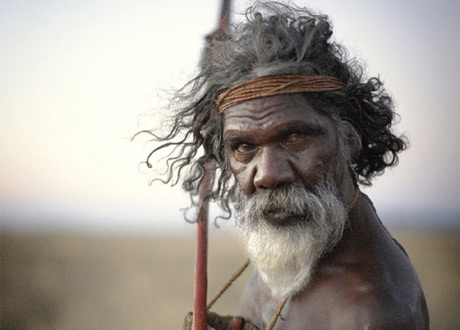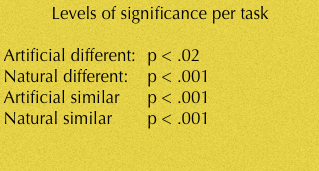Kearins (1981)
 Kearins (1981) carried out research to better understand the cognitive strategies of Indigenous Australians. This study may be used to address the following content in the sociocultural approach:
Kearins (1981) carried out research to better understand the cognitive strategies of Indigenous Australians. This study may be used to address the following content in the sociocultural approach:
The effect of culture on cognitive processes.
A video that shows the study is available here.
One of the criticisms of memory research is that it is often carried out in Western university classrooms. This creates a cultural bias in the research which may mean that the findings cannot be easily generalized. For example, the Indigenous Australians of Western Australia have followed a semi-nomadic lifestyle of hunting and gathering for almost 60.000 years. The Indigenous Australians’ survival depends on finding their way through vast stretches of unmapped country and remembering locations of water, food and wildlife. Their survival depends to a large extent on their ability to store or encode enormous amounts of environmental or visual information. This strongly contrasts with the demands on the average Western university student.
Under traditional desert living conditions, water supplies ultimately determined the movement patterns of small foraging groups. In the desert, rainfall patterns are unreliable, so these movement patterns within any particular year were never duplicated. Both hunting and gathering required that people should be able to move considerable distances in different directions from camp and return without getting lost. It is unlikely that they would identify landmarks as there are very few outstanding features in this region. However, a general sense of spatial relationships could be used to determine a location and give the hunter a sense of orientation. Accurate memory for such relationships is thus likely to have been of considerable value both in movement between water sources and in daily foraging movements from a base camp.
Indigenous Australians tend to score low on Western verbal intelligence tests. The following study by Judith Kearnins (1981) tested whether they might perform better on tests that took advantage of their ability to encode with visual cues.
Kearins (1981) had a sample of forty-four adolescent desert Indigenous Australians aged 12 - 16 years (27 boys, 17 girls) and 44 adolescents (28 boys, 16 girls) of white Australian origin. The desert group came from a school drawing children from several widely separated settlements of the Western Desert region, who had been raised by people living under semi-traditional tribal conditions. All spoke English as a second language. The white Australian participants were drawn from a large student population of a high school in an outer suburb of Perth. The sample was matched for age and sex.
The concept of "standard" testing situations is culturally foreign to Indigenous Australians. No testing was done until children had had time and opportunity to ask questions. Schoolrooms were not used for testing. The work was done entirely outdoors.
The basic procedure was that Kearins placed 20 objects on a board divided into 20 squares. Indigenous Australians and white Australian children were told to study the board for 30 seconds. The children were instructed that when the cover was removed, they should "look hard at all the things and try to remember where they all are," and that the subsequent task was a reconstruction of the board with the objects in the same arrangement. Then all the objects were heaped into a pile in the centre of the board. The children were asked to replace the items in their original locations.
There were four variations of this task.
1. Artificial different (A/D), A collection of 20 small man-made objects likely to be familiar to white Australian children (knife, eraser, thimble, die, ring, scissors, matchbox), and differing from each other in at least one other way (colour, size, shape, usage).
2. Natural different (N/D). A collection of 20 naturally occurring objects, likely to be familiar to desert children (feather, rock, bark, leaf, small skull, wildflower.).
3. Artificial same (A/S). Twelve small bottles arranged as a 4 x 3 matrix. Bottles differed in age, size, shape, colour, but were not labelled and not commonplace, so that it would be difficult to verbally distinguish between the bottles.
4. Natural same (N/S). Twelve small rocks differing in size, shape, colour, texture.
On all four tasks, the Indigenous Australian children correctly relocated more objects than did white Australian children. The chart to the left shows the level of significance for each of the four conditions.
As would be expected, the least difference between the two groups was on the artificial different task. This is the task on which the white Australian children scored the highest. The Indigenous Australian children showed no significant difference whether the task was "artificial" or "natural." This means that the objects themselves did not affect the results of the study.
According to Kearins, for many Indigenous Australian children, the memory tasks seem to have been too easy. This was especially the case for the 12-item arrays (bottles or rocks), where on over half the performances (45 of 88) no errors were made. The 20-item arrays were apparently more difficult, although about one-fifth of performances were error-free. However, the tasks were not too easy for white Australian children. Perfect performances accounted for less than 5% of total performances on both 12- and 20-item arrays. 18% of the white Australian children managed one perfect score, and none obtained two or more perfect scores. 75% of the Indigenous Australians made at least one perfect score, and 41% made at least two error-free performances.
Kearins found that the Indigenous Australian children performed significantly better than the white Australian children in placing the objects into their original locations. She concluded that the survival of the Indigenous Australians in the harsh desert landscape had encouraged and rewarded their ability to store or encode information using visual retrieval cues. These interesting results suggest that survival needs may shape and reward a particular way of encoding information in memory.
The study is a quasi-experiment - that is, the independent variable - culture - cannot be manipulated. Therefore, the findings are correlational in nature and not able to establish a cause and effect relationship. It is also a single sample. Replications of the study would have to be done with other indigenous groups in order to determine the extent to which this correlation is reliable.
It is difficult to know exactly what the reason is for this difference. Kearins argues that there must be an evolutionary root to the behaviour. Since these children were not raised in the desert, they were not raised as hunters and gatherers. They were also in a school which was run by the state of Australia. Is it possible, then, that the memory strategies are genetic? This is highly unlikely. It is more likely, as Kearins argues, that the first generation settled parents have raised their children in a way that reflects the traditional lifestyle and values. What components of this lifestyle influenced their children's ability to carry out this task so easily is rather unclear.
However, Kearins also collected a lot of qualitative data when carrying out her research. She noted that the Indigenous Australian participants sat very still and did not engage in conversation with the researcher while they viewed the arrays set before them. While reconstructing the arrays, she observed that their reconstructions of the arrays were done with careful deliberation and their progress throughout was steady. She further observed that they were very efficient and made few placement changes after their initial placements of the objects. Before placing the object that would hold it and carefully scan the board before placing it.
With regard to the Australian children, she observed that they had a tendency to move around on their seats, pick up objects, turn the objects over and talk to themselves or to the researcher. She also notes that the Australian participants seemed concerned on the same item arrays about not knowing what to call the objects to distinguish them. While reconstructing the objects, she observed that the Australian children began the process in a hurry and then slowed down and that towards the end they tended to change their initial placements around a lot.

 IB Docs (2) Team
IB Docs (2) Team

